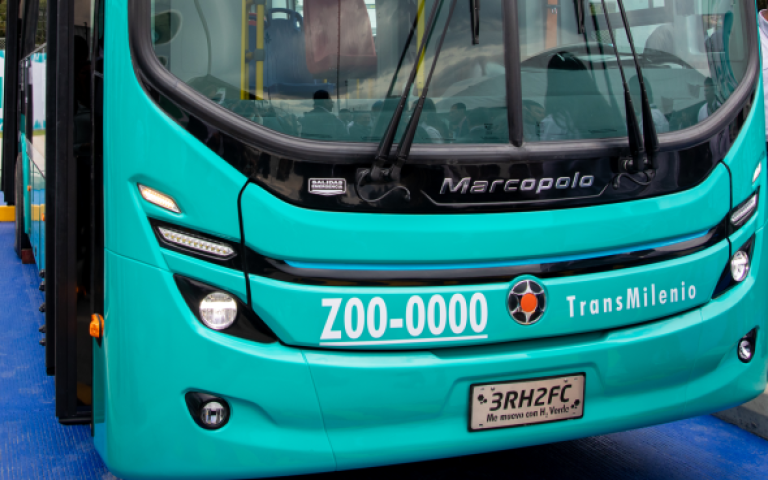With the start-up of a comprehensive operation that includes the production of low-emission hydrogen, a product compression and storage system, a service station that includes a hydrogen generator, and a public transport bus for 50 passengers, the start of the first hydrogen mobility test in Bogotá.
From the mobility park, where the Green Mobile hydrogen production, storage and service station integral system is located in the town of Fontibón, Mayor Claudia López assured that this is a great step for Bogotá in its commitment to the transition energy and the decarbonisation of public transport. “Welcome to what will be the largest electrical yard in Latin America, and the first to charge this system to hydrogen. This is a great achievement of the public and private sectors, which is why we have so much to celebrate today”, celebrated Mayor Claudia López.

The Mayoress stressed that the pilot will not stay on a bus. “The idea is to have another 13 buses very soon that can be put into operation with this electrolyser. The 23 stations of the Seventh Green Corridor will be under the same standard as the Ricaurte station that we will deliver today,” she said. In the same way, she indicated that the project is also an investment in social justice, "so that women do not take three hours of their lives to mobilize, due to lack of productivity, lack of time with the family." The president added: “For this reason, the Metro lines, the aerial cables, the public bicycle system and the improvement of platforms are part of social justice. This is investment in mobility, employment, and social justice, because two out of three people who use the transport system in the city are women”. She thanked all the actors who made this dream possible, "all our gratitude to the Minister and the President of the Republic for leading this process of energy transition and accelerating consumption towards renewable energy."
Finally, she highlighted the joint work between the private company and the public sector that today allowed this project to materialize. “To Ecopetrol, to Felipe Bayón, thank you for what he has done for Colombia, for Bogotá. This is also an achievement of engineering, Colombian workers and businessmen, who make these transformations a reality, thank you for making this possible!” she pointed out.
For his part, Felipe Bayón, president of Ecopetrol said that "this Monday is the beginning of a dream, because several years ago we have talked about decarbonizing and moving towards the possibility of having low-emission fuels, and a few years ago we have been in the route to produce this type of hydrogen”.
Bayón, assured that the total investment of the project amounts to 22,000 million pesos. "In this sense, we invite you to enjoy this day, we will not have all the answers, nor all the solutions implemented, but as a country and as a society we are taking very important steps, showing how this bus was developed, how it was adapted, and how this country has the capabilities to make these dreams come true reality,” he maintained.

The operation, which will initially take place for eight years in the Integrated Public Transport Service (SITP), seeks to evaluate variables related to the hydrogen production system and vehicle performance, as well as commercial and technological aspects of the use of this energy source. It is also expected to disseminate with the academy the knowledge that arises from this pilot. To carry out the test, a PEM (Protone exchange membrane) technology electrolyser was purchased, with an installed power of 165 kW and a production capacity of more than 23 tons of hydrogen per year. The energy comes in a first phase, from the National Interconnected System (SIN) with REC certification, which determines that its origin is exclusively from renewable sources, and in a second phase that will begin in the second half of 2023, it will come from a system of more than 2,000 solar panels of approximately 1MW for the production of green hydrogen.
A hydrogen generator is also used, which is a system to dispense energy, with the capacity to tank the bus in less than 10 minutes. In addition, at the loading site there is a cylinder storage system with a capacity of up to 140 kg.
The bus, which will transport more than 98,500 passengers a year, was assembled in Colombia by more than 100 professionals and technicians who participated in the process. It includes a fuel cell and a battery; the battery consumes hydrogen to generate electricity. The vehicle has a range of more than 450 kilometers with a single charge per day and can reach a maximum speed of 90 km/h.
The first green hydrogen bus assembled in the country is a milestone in the history of the Colombian transportation industry. The project led by the Mayor's Office of Bogotá, TransMilenio S.A., the Ecopetrol Group, the Fund for Non-Conventional Energies and Efficient Energy Management, (FENOGE), the National Auto Parts Factory FANALCA (SUPERPOLO) and Green Móvil, has technology world brand for the provision of public passenger service. The project contributes to the development of the green hydrogen roadmap drawn up by the national government to advance the energy transition and the decarbonization of public transport.

